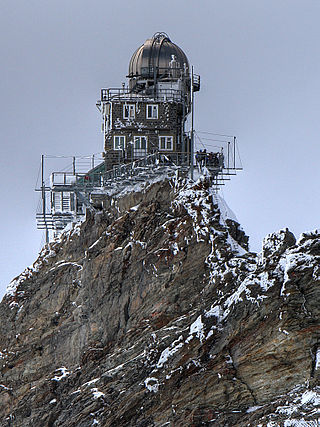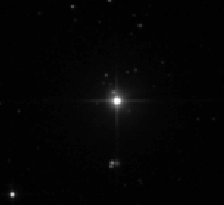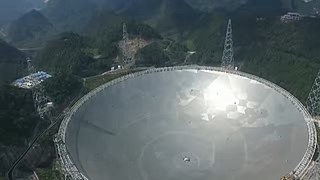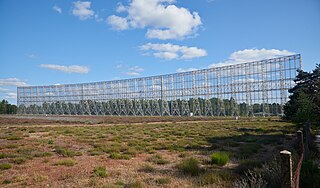Ground telescopes
Optical telescopes
| Name/Observatory | Image | Aperture | Year(s) | Location | Country(s) | Note(s) |
|---|---|---|---|---|---|---|
| Daniel K. Inouye Solar Telescope (DKIST) | | 400 cm | 2019– | Haleakalā, Maui, Hawaii, United States | [1] [2] [3] [4] | |
| Chinese Large Solar Telescope (CLST) | 180 cm | 2019– | Chengdu, Sichuan, China | First light 10 December 2019 [5] | ||
| GREGOR, Teide Observatory |  | 150 cm | 2012– | Tenerife, Spain | [6] | |
| Goode Solar Telescope (GST), Big Bear Solar Observatory |  | 160 cm | 2008– | California, United States | ||
| New Vacuum Solar Telescope (NVST), Yunnan Astronomical Observatory | 100 cm | 2010– | Yunnan, China | 100 cm vacuum solar telescope [7] | ||
| Andrei Severny Tower Solar Telescope, Crimean Astrophysical Observatory |  | 90 cm | 1954– | Crimea | ||
| Multi-Purpose Automated Solar Telescope, Sayan Solar Observatory | 80 cm | Mondy, Republic of Buryatia, Russia | Located in the mountains at 2000m altitude. [8] | |||
| Large Solar Vakuum Telescope, Baikal Astrophysical Observatory |  | 76 cm | 1980– | Irkutsk Oblast, Russia | Located on the Coast of Lake Baikal. [8] | |
| Optical and Near-Infrared Solar Eruption Tracer (ONSET), School of Astronomy & Space Science, Nanjing University | 3x27,5 cm | 2010– | Nanjing, China | The ONSET consists of four tubes: (1) a near-infrared vacuum tube, with an aperture of 27.5 cm, (2) a chromospheric vacuum tube, with an aperture of 27.5 cm, (3) a WL vacuum tube, with an aperture of 20 cm and (4) a guiding tube. [9] | ||
| Bulgarian 15-cm Solar Coronagraph, [10] Rozhen National Astronomical Observatory Bulgaria | 100 cm | 2005– | Rozhen, Bulgaria | |||
| Swedish Solar Telescope (SST), Roque de los Muchachos Observatory |  | 100 cm | 2002– | La Palma, Spain | [11] | |
| Prairie View Solar Observatory (PVSO) [12] |  | 35 cm | 1999– | Texas, United States | ||
| Upgraded Coronal Multi-Channel Polarimeter (UCOMP) | 20 cm | 2021– | Mauna Loa, Hawaii, United States | |||
| K-Coronagraph (K-COR) | 20 cm | 2013– | Mauna Loa, Hawaii, United States | |||
| Dutch Open Telescope (DOT), Roque de los Muchachos Observatory |  | 45 cm | 1997– | La Palma, Spain | ||
| THÉMIS Solar Telescope, Teide Observatory |  | 90 cm | 1996– | Tenerife, Spain | ||
| Vacuum Tower Telescope (VTT), Teide Observatory |  | 70 cm | 1989– | Tenerife, Spain | [13] | |
| Hida Domeless Solar Telescope (ja) | 60 cm | 1979– | Takayama, Gifu, Japan | [14] | ||
| Udaipur Solar Observatory MAST Full Disk H-alpha Telescope H-alpha Spar Telescope Coudé Telescope |  | 50 cm 15 cm 25 cm 15 cm | 1976– | Udaipur, India | ||
| Richard B. Dunn Solar Telescope (DST), Sacramento Peak |  | 76 cm | 1969– | Sunspot Solar Observatory, Sunspot, New Mexico, United States | ||
| Solar Observatory Tower Meudon | | 60 cm | 1968– | Meudon, France | ||
| McMath–Pierce solar telescope, KPO | | 161 cm | 1961– | Arizona, United States | Largest aperture optical and infrared solar telescope for nearly six decades | |
| ARIES Observatory | 15 cm | 1961– | Nainital, India | |||
| Solar Tunnel Telescope, Kodaikanal Solar Observatory |  | 61 cm (24 in) | 1958– | Kodaikanal, India | [15] | |
| 45-cm-Turmteleskop | 45 cm | 1943– | Schauinsland, Germany | |||
| Gregory Coudé Telescope |  | 45 cm | 1959- | Locarno, Switzerland | Operated by the Universitäts-Sternwarte Göttingen until 1984 and by IRSOL after 1984. | |
| Solar Tower Telescope by Zeiss | 45 cm | 1930– | Tokyo, Japan | [16] | ||
| Einsteinturm | | 60 cm | 1924– | Potsdam, Germany | ||
| 150-foot tower, Mount Wilson Observatory |  | 35 cm (24") | 1912– | California, United States | [1] | |
| Snow Solar Telescope, Mount Wilson Observatory | 61 cm (24") | 1904– | California, United States | First solar telescope [17] | ||
| Lerebour/Grubb-Parsons, Kodaikanal Solar Observatory |  | 20 cm | 1901– | Kodaikanal, India | ||
| Solar-T | 2x7.6 cm | 2016 | Antarctica | [18] | ||
| Swedish Vacuum Solar Telescope, Roque de los Muchachos Observatory | 47.5 cm | 1985–2000 | La Palma, Spain | Replaced by the SST | ||
| Gregory Coude Telescope (GCT) | 45 cm [1] | 1984–2002 | Tenerife, Spain (1984–2002) | Replaced by GREGOR [19] [1] | ||
| Evans Solar Facility (ESF), Sacramento Peak | 40 cm | 1953–2014 | Sunspot Solar Observatory, Sunspot, New Mexico, United States | [20] | ||
| Göttinger Sonnenturm (Solar Tower Telescope) | 2x15 cm 11 cm | 1942–2004 | Göttingen, Germany | 65 cm-Coelostat by Zeiss, feeding light into several small light paths in tower | ||
| McMath-Hulbert Observatory | 61 cm (24") | 1941–1979 | Michigan, United States | Replaced the 10.5in in 1941 | ||
| 50-foot tower, McMath-Hulbert Observatory | 40 cm | 1936–1979 | Michigan, United States | |||
| 10.5 inch, McMath-Hulbert Observatory | 26.7 cm (10.5") | 1930–1941 | Michigan, United States | Replaced by the 24 inch in 1941 | ||
| Arcetri Solar Tower, Arcetri Observatory |  | 37 cm | 1925-2006 | Arcetri, Italy | ||
Telescopes for the Sun have existed for hundreds of years, this list is not complete and only goes back to 1900.
Potential future optical telescopes
| Name/Observatory | Image | Aperture d. | Status | Location | Country(s) | Note |
|---|---|---|---|---|---|---|
| Coronal Solar Magnetism Observatory (COSMO) | 150 cm | proposed | [21] | |||
| National Large Solar Telescope (NLST) | 200 cm | proposed [22] | Merak Village, Ladakh, India | |||
| Chinese Giant Solar Telescope (CGST) | 500–800 cm | planned | Western part of China | [23] | ||
| European Solar Telescope (EST) | 400+ cm | planned | Canary Islands | 15 European countries [24] | [25] | |
Radio telescopes
| Name/Observatory | Image | Frequency range | Year(s) | Location | Country(s) | Note(s) |
|---|---|---|---|---|---|---|
| Chinese Spectral Radioheliograph (CSRH) | | 0.4 - 2.0 Ghz 2.0 - 15 GHz | 2013 - | Inner Mongolia, China | 40x 4.5m dishes - low freq band 60x 2m dishes - high freq band Radio imaging-spectroscopy observations of the Sun in decimetric and centimetric wavelengths [26] | |
| Nançay Radioheliographe (NRH), Nançay Radio Observatory | | 150–450 MHz | Sologne, Centre-Val de Loire, France | [27] | ||
| Expanded Owens Valley Solar Array (EOVSA) |  | 1–18 GHz | Sologne, Centre-Val de Loire, France | Previously known as the Owens Valley Solar Array (OVSA) before getting an expansion to upgrade its control system and increase the total number of antennas to 15. [28] | ||
| Nobeyama Radioheliograph (NoRH), Nobeyama Radio Observatory | 17 and 34 GHz | Minamimaki, Nagano Prefecture, Japan | [29] | |||
| Nobeyama Radio Polarimeters, Nobeyama Radio Observatory | 1, 2, 3.75, 9.4, 17, 35, and 80 GHz | Minamimaki, Nagano Prefecture, Japan | [30] | |||
| Siberian Solar Radio Telescope (SSRT) | | 1983– | Republic of Buryatia, Russia | [31] | ||
| Solar Submillimeter Telescope (SST), Complejo Astronomico El Leoncito |  | 212 and 405 GHz | 1999– | San Juan Province, Argentina | SST is the only solar submillimeter telescope currently in operation. [32] | |
| Polarization Emission of Millimeter Activity at the Sun (POEMAS), Complejo Astronomico El Leoncito |  | 45 and 90 GHz | 2011– | San Juan Province, Argentina | ||
| Bleien Radio Observatory |  | 10 MHz–5 GHz | 1979– | Gränichen, Switzerland | [33] | |
| Radio Solar Telescope Network (RSTN) | 245, 410, 610, 1415, 2695, 4975, 8800 and 15400 MHz | Australia; Italy; Massachusetts and Hawaii, United States | A series of four radio telescopes located at various locations around the world. [33] [34] | |||
| Daocheng Solar Radio Telescope |  | 150-450 MHz | 2023- | Sichuan province | 313 parabolic antennas for detection of coronal mass ejection events. Operations started in 2023. [35] | |
| Mingantu interplanetary scintillation telescope | 327 MHz and 654 MHz | 2023- | Inner Mongolia | interplanetary scintillation telescope, consists of three rotatable cylindrical antennas (140 metres by 40 metres each). [36] | ||
















